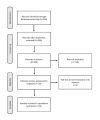Making Video Games More Inclusive for People Living With Motor Neuron Disease: Scoping Review
- PMID: 39714921
- PMCID: PMC11704651
- DOI: 10.2196/58828
Making Video Games More Inclusive for People Living With Motor Neuron Disease: Scoping Review
Abstract
Background: Evidence suggests that individuals with motor neuron disease (MND), a terminal illness, find enjoyment and social connection through video games. However, MND-related barriers can make gaming challenging, exacerbating feelings of boredom, stress, isolation, and loss of control over daily life.
Objective: We scoped the evidence to describe relevant research and practice regarding what may help reduce difficulties for people with MND when playing video games.
Methods: A scoping review was conducted using the Arksey and O'Malley framework, recent scoping review guidance, and engaging with people with lived experience of MND. Peer-reviewed studies were sourced from PubMed and the Swinburne University of Technology Library. Gray literature was identified from government, not-for-profit, commercial, and community websites. Data were extracted and summarized from the collected literature.
Results: The evidence base, consisting of quantitative and qualitative research, lived experience stories, information resources, reviews, and guidelines, included 85 documents. Only 8 (9%) directly addressed video games and people with MND; however, these studies were limited in depth and quality. The primary technologies examined included customized information and communications technology for communication and control of computing systems (including desktop, laptop, smartphone, tablet, and console systems) and video game software and hardware (including hand controllers and accessibility features, such as difficulty level, speed, and remappable buttons and controls). Common factors in the evidence base highlight barriers and enablers to enjoying video games for people with MND. These include technological, physical, social, and economic challenges. Addressing these requires greater involvement of people with MND in game and technology research and development. Changes to information and communications technology, game software and hardware, policies, and guidelines are needed to better meet their needs.
Conclusions: There is a significant gap in understanding the lived experience of people with MND with video games and what makes playing them easier, including appropriate customization of technology and the social experience of games. This gap perpetuates exclusion from gaming communities and recreation, potentially worsening social isolation. Existing evidence suggesting viable options for future research and practice. Video game and information and communications technology research and development must prioritize qualitative and quantitative research with people with MND at an appropriate scale, with a focus on lived experience, use of improved participant engagement techniques, and user-focused design for more inclusive games. Practical work needs to increase awareness of what can help make games more inclusive, including incorporation of accessibility early in the game production process, early incorporation of accessibility in game production, and affordable options for customized interfaces and other devices to play games.
Keywords: disability; inclusion; information technology; mobile phone; motor neuron disease; video games; well-being.
©Ben O'Mara, Matthew Harrison, Kirsten Harley, Natasha Dwyer. Originally published in JMIR Rehabilitation and Assistive Technology (https://rehab.jmir.org), 23.12.2024.
Conflict of interest statement
Conflicts of Interest: BO was the information resources manager at Motor Neurone Disease Australia for significant periods during the conduct of this review. KH was a board member of Motor Neurone Disease New South Wales for significant periods during the conduct of this review.
Figures
References
-
- Mackenzie L, Bhuta P, Rusten K, Devine J, Love A, Waterson P. Communications technology and motor neuron disease: an Australian survey of people with motor neuron disease. JMIR Rehabil Assist Technol. 2016 Jan 25;3(1):e2. doi: 10.2196/rehab.4017. https://rehab.jmir.org/2016/1/e2/ v3i1e2 - DOI - PMC - PubMed
-
- Araki T. Amyotrophic Lateral Sclerosis. Melbourne, Australia: Australia Exon Publications; 2021. - PubMed
-
- Hogden A, Foley G, Henderson RD, James N, Aoun SN. Amyotrophic lateral sclerosis: improving care with a multidisciplinary approach. J Multidiscip Healthc. 2017;10:205–15. doi: 10.2147/JMDH.S134992. https://dx.doi.org/10.2147/JMDH.S134992 jmdh-10-205 - DOI - DOI - PMC - PubMed
-
- Lau FS, Brennan FP, Gardiner MD. Multidisciplinary management of motor neurone disease. Aust J Gen Pract. 2018 Sep;47(9):593–7. doi: 10.31128/AJGP-02-18-4495. https://www.racgp.org.au/AJGP/2018/september/multidisciplinary-managemen... - DOI - PubMed
Publication types
LinkOut - more resources
Full Text Sources
Miscellaneous



